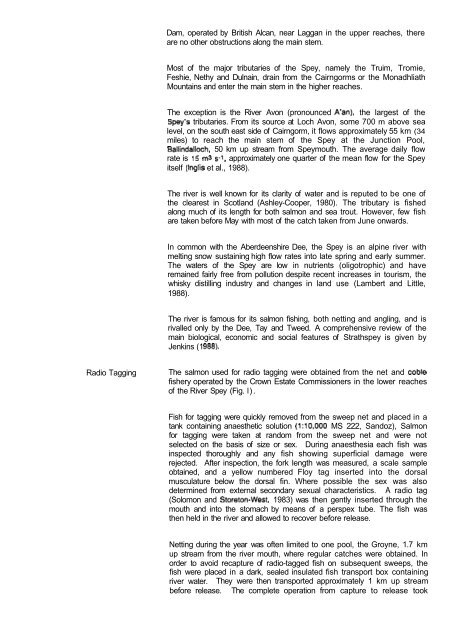( Salmo salar L.) in the River Spey as determined by
( Salmo salar L.) in the River Spey as determined by
( Salmo salar L.) in the River Spey as determined by
You also want an ePaper? Increase the reach of your titles
YUMPU automatically turns print PDFs into web optimized ePapers that Google loves.
Dam, operated <strong>by</strong> British Alcan, near Laggan <strong>in</strong> <strong>the</strong> upper reaches, <strong>the</strong>re<br />
are no o<strong>the</strong>r obstructions along <strong>the</strong> ma<strong>in</strong> stem.<br />
Most of <strong>the</strong> major tributaries of <strong>the</strong> <strong>Spey</strong>, namely <strong>the</strong> Truim, Tromie,<br />
Feshie, Nethy and Dulna<strong>in</strong>, dra<strong>in</strong> from <strong>the</strong> Cairngorms or <strong>the</strong> Monadhliath<br />
Mounta<strong>in</strong>s and enter <strong>the</strong> ma<strong>in</strong> stem <strong>in</strong> <strong>the</strong> higher reaches.<br />
The exception is <strong>the</strong> <strong>River</strong> Avon (pronounced A'an), <strong>the</strong> largest of <strong>the</strong><br />
<strong>Spey</strong>'s tributaries. From its source at Loch Avon, some 700 m above sea<br />
level, on <strong>the</strong> south e<strong>as</strong>t side of Cairngorm, it flows approximately 55 km (34<br />
miles) to reach <strong>the</strong> ma<strong>in</strong> stem of <strong>the</strong> <strong>Spey</strong> at <strong>the</strong> Junction Pool,<br />
Ball<strong>in</strong>dalloch, 50 km up stream from <strong>Spey</strong>mouth. The average daily flow<br />
rate is 15 m3 S-1, approximately one quarter of <strong>the</strong> mean flow for <strong>the</strong> <strong>Spey</strong><br />
itself (Inglis et al., 1988).<br />
The river is well known for its clarity of water and is reputed to be one of<br />
<strong>the</strong> clearest <strong>in</strong> Scotland (Ashley-Cooper, 1980). The tributary is fished<br />
along much of its length for both salmon and sea trout. However, few fish<br />
are taken before May with most of <strong>the</strong> catch taken from June onwards.<br />
In common with <strong>the</strong> Aberdeenshire Dee, <strong>the</strong> <strong>Spey</strong> is an alp<strong>in</strong>e river with<br />
melt<strong>in</strong>g snow susta<strong>in</strong><strong>in</strong>g high flow rates <strong>in</strong>to late spr<strong>in</strong>g and early summer.<br />
The waters of <strong>the</strong> <strong>Spey</strong> are low <strong>in</strong> nutrients (oligotrophic) and have<br />
rema<strong>in</strong>ed fairly free from pollution despite recent <strong>in</strong>cre<strong>as</strong>es <strong>in</strong> tourism, <strong>the</strong><br />
whisky distill<strong>in</strong>g <strong>in</strong>dustry and changes <strong>in</strong> land use (Lambert and Little,<br />
1988).<br />
The river is famous for its salmon fish<strong>in</strong>g, both nett<strong>in</strong>g and angl<strong>in</strong>g, and is<br />
rivalled only <strong>by</strong> <strong>the</strong> Dee, Tay and Tweed. A comprehensive review of <strong>the</strong><br />
ma<strong>in</strong> biological, economic and social features of Strathspey is given <strong>by</strong><br />
Jenk<strong>in</strong>s (1 988).<br />
Radio Tagg<strong>in</strong>g<br />
The salmon used for radio tagg<strong>in</strong>g were obta<strong>in</strong>ed from <strong>the</strong> net and coble<br />
fishery operated <strong>by</strong> <strong>the</strong> Crown Estate Commissioners <strong>in</strong> <strong>the</strong> lower reaches<br />
of <strong>the</strong> <strong>River</strong> <strong>Spey</strong> (Fig. l).<br />
Fish for tagg<strong>in</strong>g were quickly removed from <strong>the</strong> sweep net and placed <strong>in</strong> a<br />
tank conta<strong>in</strong><strong>in</strong>g anaes<strong>the</strong>tic solution (1:10,000 MS 222, Sandoz), <strong>Salmo</strong>n<br />
for tagg<strong>in</strong>g were taken at random from <strong>the</strong> sweep net and were not<br />
selected on <strong>the</strong> b<strong>as</strong>is of size or sex. Dur<strong>in</strong>g anaes<strong>the</strong>sia each fish w<strong>as</strong><br />
<strong>in</strong>spected thoroughly and any fish show<strong>in</strong>g superficial damage were<br />
rejected. After <strong>in</strong>spection, <strong>the</strong> fork length w<strong>as</strong> me<strong>as</strong>ured, a scale sample<br />
obta<strong>in</strong>ed, and a yellow numbered Floy tag <strong>in</strong>serted <strong>in</strong>to <strong>the</strong> dorsal<br />
musculature below <strong>the</strong> dorsal f<strong>in</strong>. Where possible <strong>the</strong> sex w<strong>as</strong> also<br />
determ<strong>in</strong>ed from external secondary sexual characteristics. A radio tag<br />
(Solomon and Storeton.West, 1983) w<strong>as</strong> <strong>the</strong>n gently <strong>in</strong>serted through <strong>the</strong><br />
mouth and <strong>in</strong>to <strong>the</strong> stomach <strong>by</strong> means of a perspex tube. The fish w<strong>as</strong><br />
<strong>the</strong>n held <strong>in</strong> <strong>the</strong> river and allowed to recover before rele<strong>as</strong>e.<br />
Nett<strong>in</strong>g dur<strong>in</strong>g <strong>the</strong> year w<strong>as</strong> often limited to one pool, <strong>the</strong> Groyne, 1.7 km<br />
up stream from <strong>the</strong> river mouth, where regular catches were obta<strong>in</strong>ed. In<br />
order to avoid recapture of radio-tagged fish on subsequent sweeps, <strong>the</strong><br />
fish were placed <strong>in</strong> a dark, sealed <strong>in</strong>sulated fish transport box conta<strong>in</strong><strong>in</strong>g<br />
river water. They were <strong>the</strong>n transported approximately 1 km up stream<br />
before rele<strong>as</strong>e. The complete operation from capture to rele<strong>as</strong>e took
















